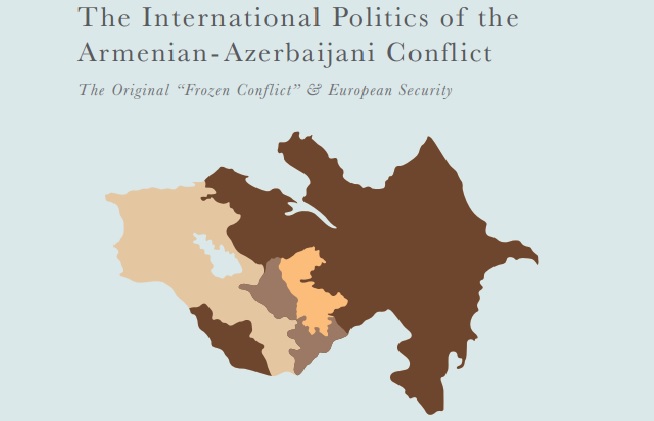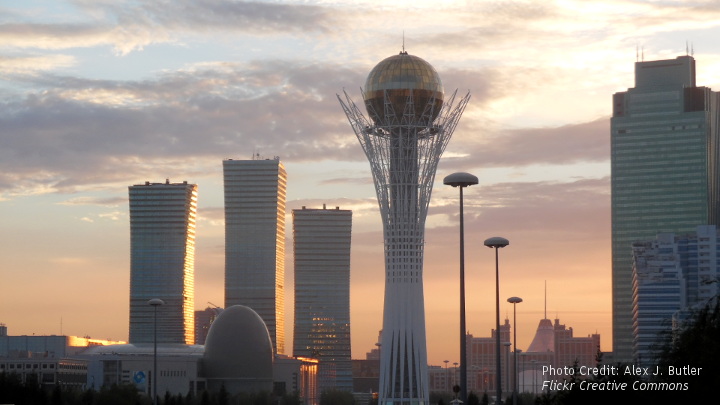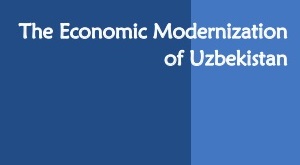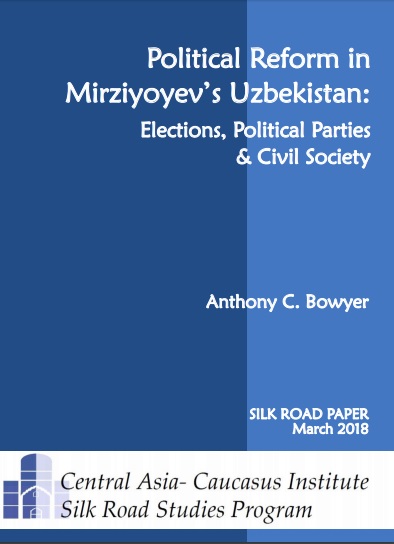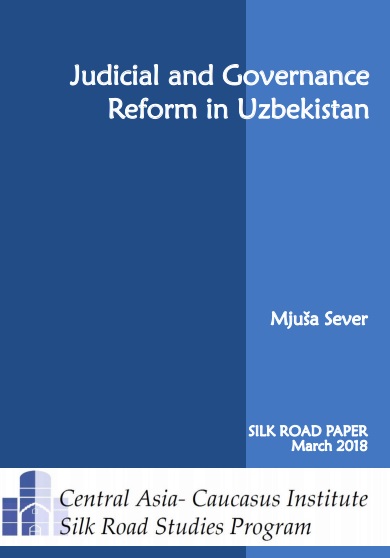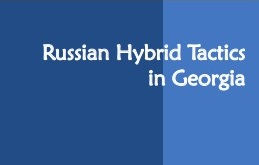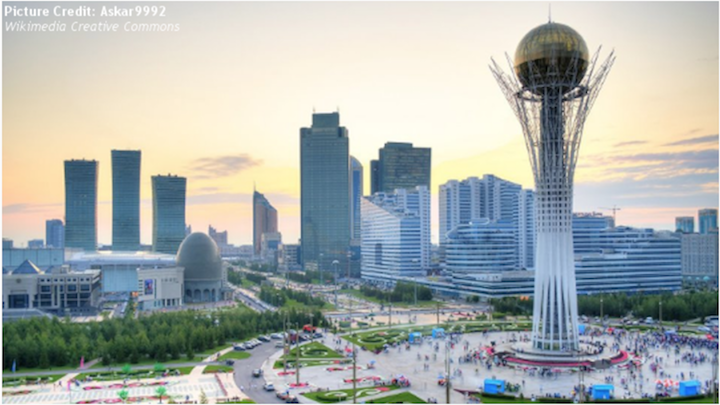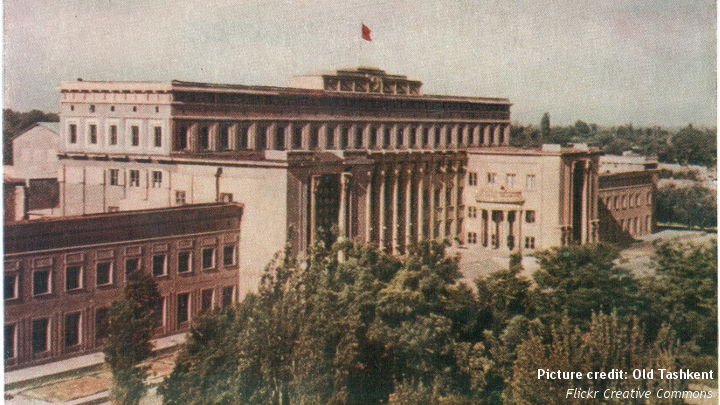Silkroad Papers and Monographs
The Economic Modernization of Uzbekistan
Political Reform in Mirziyoyev's Uzbekistan: Elections, Political Parties and Civil Society
Silk Road Paper
March 2018
Executive Summary
Since taking over from long-time President Islam Karimov in 2016, President Shavkat Mirziyoyev has pursued an aggressive policy to transform Uzbekistan’s decision-making processes, invigorate civil society, encourage political competition, address human rights and develop a civic culture consistent with the country’s status as a modernizing, forward-looking regional power in Eurasia with a steadily increasing majority of citizens under the age of 30. To declare significant these changes, which seem to take place daily, is to perhaps understate their potential in light of the last 30 years of history.
The transformation presently underway has its roots in the appointment of Mirziyoyev to the post of Prime Minister in 2003, after which he quietly worked to diversify the voices heard in national political discussions, though recognized the barriers that were preventing the country from using its vast human capital to meet the demands of an emerging power in the twenty-first century.
The various programs proposed by the new president and presently under implementation hold the promise of reshaping the domestic political landscape, changing the fundamental relationship between the citizen and state, and rebalancing the geopolitical order in a region long relegated as the domain of outside great powers.
Ahead of the December 2016 Presidential elections, Mirziyoyev campaigned on the principle of a government with a greater degree of openness and transparency serving the people – a novelty in the experience of independent Uzbekistan and most other post-Soviet countries.
To advance this agenda, President Mirziyoyev issued three key documents: A Program to Reform the Judicial and Legal System; an Action Strategy on Five Priority Areas of the Country’s Development for 2017-2021; and a “Concept” of Administrative Reform.
The Program and Action Strategy, which focus on ensuring the rule of law, reforming the judicial system, promoting economic liberalization, and the development of the social sphere, contains numerous sub-objectives which, if fully implemented, will fundamentally transform the relationship between Uzbekistan’s government and its people, and elevate independent civic advocacy organizations and informal institutions, such as Mahallas, to the status of partners of the government.
The Concept for Administrative Reform aims to result in an effective and transparent system of public administration capable of protecting the rights of citizens and bolstering Uzbekistan’s economic competitiveness globally. It defined six priority areas, among which are; “the improvement of the institutional, organizational, and legal framework of the executive authorities’ activities” and “the formation of an effective system of professional civil service, [and] the introduction of effective mechanisms to combat corruption in the system of executive authorities.”
The Concept was developed with the participation of academics, practitioners, representatives of both international organizations and civic advocacy organizations based in Uzbekistan. In developing both the Action Strategy and the Concept, the government worked to solicit participation from the general public in order to present the Concept and receive critical feedback on its further development and implementation.
There have also been steps to change Uzbekistan’s electoral system and the situation concerning political parties. Constitutional changes already in 2014, sought to redistribute power between the parliament and the executive, granting more decision-making power and control over the executive to the Parliament. Quite early on, President Mirziyoyev proposed to make governors and mayors directly elected by the people, as opposed to appointed by the President. In August 2017, legislation was amended by decree to allow for the direct election of Khokims of Wiloyats and the city of Tashkent, and set a date for Tashkent city elections, which took place on December 24, 2017.
In the coming months and years, one can expect further substantive changes to local and regional government, with the likelihood of many new faces in positions of authority, all of them popularly elected for the first time in Uzbekistan’s independent statehood. The new leaders will have to be closely watched to determine whether they are acting on behalf of citizens or are drawn back into regional or local loyalty networks. In the end, direct local elections are a necessary but not sufficient condition for progress: the elections also need to be professionally and fairly administered at all levels – particularly the often-compromised District and Precinct Election Commissions. Furthermore, they must be scrutinized by active, independent NGO monitors.
The President also called on the parliament to be much more active in legislation. He prodded parliamentarians to get out of their offices and travel around the country to meet people, especially the youth, hear their concerns and come back with proposals on how to resolve the problems identified by citizens. He urged them to analyze proposed legislation and propose improvements. The President also suggested that political parties connect with foreign counterparts, which had been the norm up until the mid-1990s but in more recent years had been seen in a more negative light.
This brought results: parliamentarians now regularly visit rural areas, where they have appeared in live talk shows, used social media, participated in focus groups, and tried overall to become more connected with their constituents. However, there is still a long way to go in order to achieve a strong, multiparty system that accepts and encourages diversity of platforms and programs, and does not perceive opposing policies as anathema to the state.
Expanded competition among the five legally-registered political parties is likely to stimulate them to refine their platforms, redouble efforts to support gender equality and inclusion, engage more of the country’s young and future voters, and seek diversity within their ranks. The emergence of a more open political system that embraces freedom of speech, association and assembly will offer an opportunity for all political actors to flourish.
Mirziyoyev’s reforms have also had important implications for civil society. Rather than an adversary, the government now seeks to view civil society as an ally in its reform agenda. This was manifested in numerous legislative amendments and initiatives to ease the ability of NGOs to operate in the country. Since Mirziyoyev took office as Interim President in September 2016, 685 local civic advocacy organizations have successfully registered with the Ministry of Justice, more than an 8 percent increase. There remains much work to be done until impediments to the work of NGOs are completely removed, but the progress is clear.
An overarching goal of the President’s reform program and Action Strategy is to root out corruption and inefficiency at the local and national levels of government. The translation of written objectives into demonstrable action has proceeded apace, as local administrators from a multitude of governmental departments have been called to answer for their actions in a very public way, resulting in presidential chastisements and numerous officials being sacked for a variety of offenses.
After Mirziyoyev criticized the performance of the Ministry of Finance, it fired 562 officials. After the President denounced officials who use vulgar language in interactions with citizens, a mayor was fined for insulting a citizen, a “first” in Uzbekistan. These moves put officials at all levels of government on notice and confirm that Mirziyoyev is serious about his pledge to make government accountable to the people. But most importantly, the President proceeded to remove the leadership of both the Prosecutor General’s office and the National Security Service, institutions that had been highly influential and feared in society. Reforms in these institutions will be key to the reform agenda as a whole, and particularly to the struggle against corruption.
Almost half of Uzbekistan’s population is under 25 years of age, and as such, the outlook of the young generation will determine the country’s future. The Action Strategy prioritizes education as the cornerstone of the government’s approach to the rising generation, calling for greater standardization of basic education and for gender equality. It is expected that economic growth and training provided by the country’s four-hundred vocational-technical “colleges” will go far towards creating the new jobs that are so urgently needed. These are also the cornerstones of the government’s program to reduce radicalization among Uzbekistan’s youth.
President Mirziyoyev nonetheless used a speech before the United Nations to argue that the provision of education and opportunities for young people is a global demand, and not purely national. Beyond these points, he has consistently underscored the need for tolerance, and calls for communicating what he calls “the truly humanistic essence of Islam both to young people and the world at large, where intolerance of Muslims is growing.” However, President Mirziyoyev has yet to stress the importance of a secular state with secular laws and courts as a sine qua non for a humane and open civic culture.
President Mirziyoyev has demonstrated a commitment to revisiting Uzbekistan’s human rights record on an international scale. One key step in this regard was the invitation extended to the United Nations High Commissioner for Human Rights. The Uzbek government announced it would allow a permanent representative of the Office of the High Commissioner for Human Rights to be based in Tashkent, and invited Human Rights Watch to resume activities in the country.
Among tasks still to be faced are to implement reforms of local government, promote accountability and transparency, implement direct elections for regional and local Khokims, encourage Mahallas to cooperate with local government, and follow through on the democratization program, as set forth in the Action Strategy. None of these tasks will be simple or short-term. Both active and passive resistance can be predicted: the National Security Service and the Finance Ministry both initially resisted a number of key reforms and may have sought to check the President’s efforts. Such incidents may be signs of possible future concerns.
However, even if all key figures continue to firmly support the new president, implementing the governance reforms proposed by Mirziyoyev will pose a formidable challenge. Besides structural changes, they call for fundamental shifts in the political culture and even the mentality of ordinary Uzbeks. Public passivity and inertia can delay or derail reforms at many levels, as can the exercise of too much or too little force from above. This will be all the more complex when it is done in the context of the new president’s stated goal of broadening the political spectrum and promoting greater diversity of opinion.
Judicial and Governance Reform in Uzbekistan
Silk Road Paper
March 2018
Executive Summary
Since President Mirziyoyev assumed power as interim president in September 2016, a major agenda of reforms has been introduced in Uzbekistan. In this broader agenda, judicial and governance reform has been identified as key to the entire reform process.
The scope and speed of reforms outlined in this study are bold and unprecedented. Given the systematically negative coverage of developments in Uzbekistan prior to the transition of power, these reforms may appear to have emerged ex nihilo. But while little of a positive nature was reported, many of the reforms under Mirziyoyev trace their origins to developments in the past decade. Indeed, already in 2005, reforms in the judicial sector introduced habeas corpus and abolished the death penalty.
While change was slow, by 2010 the Uzbek government was convinced of the need for greater outreach to the international community. In subsequent years, reforms introduce the separation of powers, and strengthened the office of the Ombudsman. By 2014-15, a major effort was underway at the Ministry of Justice to reorganize and improve the legal system. The generational factor was important in this process: younger officials, often with foreign education, had begun to rise through the ranks and take on greater responsibilities. By 2015, the prior aversion to bring discussions on important issues to the public had begun to be overcome.
That said, when Prime Minister Shavkat Mirziyoyev assumed the position of Interim President, he rapidly sent a major jolt through the system and launched the country’s institutions on a path to rapid and comprehensive reform. Early on, he stated outright the principle underlying his actions: “It is time to end the period when people worked for the government. Instead, the government must start working for the people!”
Indeed, while still only the interim President, Mirziyoyev opened himself to direct access through the Internet via his so-called “virtual office.” During a later address to Parliament, he advised parliamentarians to start doing the same. Parliamentarians then began taking regular trips to the countryside to meet with their constituents. The Governors, though still appointed by the President, were instructed to hold periodic receptions in all regions. These are now obligatory in every region.
Mirziyoyev’s insistence on putting the people’s voice on the record appears to have shifted the political atmosphere in his favor overnight. It vastly increased the popularity of both his national and local policies, allowed for an evaluation of the results of his national and local policies, and it provided him with the support necessary to start introducing substantial reforms and changes. This was is a novel development in Uzbek political life, and offers citizens a new mechanism for influencing the administration’s performance, and serves as kind of watchdog, while at the same time allowing officials direct contact with citizens in a way that makes them more susceptible to their problems and concerns.
The Initial reforms came in the form of presidential decrees. These included substantial judicial reforms and strict anticorruption measures. An October 2016 decree sought to reform the judicial system and strengthen the protection off rights and freedoms. It called, among other, for a review of more than seven hundred legal acts spread over more than 90,000 pages. This was followed up by legislation that took measures to strengthen public trust in judiciary. A new Anticorruption Law was entered into force in early January 2017, and was followed by a state anticorruption program.
After being elected President in January 2017, Mirziyoyev announced a comprehensive “Five Point Development Strategy Plan” outlining policy priorities for a five-year period. This Plan focused on improving the system of state and social construction; strengthening the rule of law and the judicial system; developing and liberalizing the economy; developing the social sphere; and improving security and implementing a balanced foreign policy.
The main legislative role in coordinating reforms was assigned to the Ministry of Justice, now staffed by an entirely new set of young officials. It was tasked with implementing administrative reforms, assuring that other ministries meet deadlines, reviewing draft legislation and internal regulations to bring them into line with the Constitution; and assuring that new laws comply with international standards and conventions.
A crucial element of the overall reform process is the strong political support accorded to the younger generation. Many talented young officials have been promoted to responsible posts, including as ministers and deputy ministers, and a position of State Adviser on Youth has been added to the President’s Cabinet. The inclusion of the younger generation led the administration to begin to pulse with new ideas. Rigidly bureaucratic modes of official interaction were abandoned as communication began to catch up with worldwide practice.
Also in January 2017, a package of judicial reforms were introduced . These aimed at ensuring that the judiciary is truly independent; increasing the authority of the courts; and at democratizing and improving the judicial system on the basis of the best national and international practices. Also highlighted were the objectives of guaranteeing the protection of citizens’ rights and freedoms; improving administrative, criminal, civil and commercial law; fighting crime and advancing crime prevention, including anticorruption measures; and strengthening the rule of law and building public trust in the legal system through communication with the public and media.
A key step in this direction was Mirziyoyev’s handling of the previously all-powerful General Prosecutor’s Office. At a January 2017 meeting with prosecutors, President Mirziyoyev stated that the country needed to establish efficient public control over this body lest it again be perceived as a repressive and retaliatory institution. Sweeping changes were imposed on the internal structures and personnel of the Procuracy, designed to fundamentally transform what, along with the Ministry of the Interior and the Security Service, had long been the country’s most powerful institution. The newly appointed senior staff at the General Prosecutor’s Office appears clearly devoted to these reforms. The Ministry of Interior underwent similar reforms, including the screening and restructuring of its staff, while the Police Academy is undergoing an internal review as well.
A key area of reform has been the restructuring of legal education. A Presidential decree of April 2017 focused on the Tashkent State University of Law. As a result, the curriculum was updated, teaching methods modernized, and a credit system introduced. The old lecture-based approach was abandoned in favor of experiential learning. The university proceeded to hire many young professionals, some with foreign degrees. The University’s ambition now is to become the regional hub for legal studies in Central Asia. Along with these reforms, changes have been introduced also in continuing education. The Supreme Court is preparing to establish an Academy to train judges, candidates for judgeships, and other court personnel.
While these reforms during the past eighteen months would have been unimaginable only recently, much still remains to be done. One example is to devise a stronger role for defense counsels and the development of a road map on how to strengthen the independence and professional capabilities of those lawyers. Tight state controls over the licensing of defense counsels long ensured that these officers of the court would remain weak. While ongoing reforms correctly envision the role of defense counsels, little has been done to date to implement the changes that are urgently necessary.
By December 2017, President Mirziyoyev sought to further accelerate the pace of reforms. In a widely distributed speech to a joint session of parliament, he spoke of many areas in need of further reforms. This included the need to reform civil service law, and to delineate the scopes and functions of executive bodies. Another area of focus was to reduce administrative influence on economic life and transition to an economy dominated by market mechanisms. This will include transferring functions from the state to the private sector. Mirziyoyev also emphasized the anti-corruption struggle, and the need to strengthen the role of parliament. He addressed the need to improve mobility and reduce the prevalence of domestic checkpoints. But most importantly, he directly targeted the National Security Service, decrying its pervasive influence on all sectors of the state and society. Soon after, the President retired the highly influential Head of the Security Service, who had been in place for almost two decades, and launched an effort to modernize the Security Services as well.
While these reforms are a work in progress, and many remain at the declarative level, they have already had important implications. For example, the enlivened new leadership transformed Uzbekistan’s previously dull media environment almost overnight. News in Uzbekistan nowadays is meaningful, timely and critical. It is true that media still mask criticism behind quotes from political leaders, but they no longer speak with only one voice. The media have become more timely and trustworthy, with more reporting on international affairs as well. The government claims that it wants the media to be stronger. Still missing in the present media coverage, however, are analytical articles and editorials that critically review the ongoing reform processes around the country. The country’s media is yet to incorporate and engage in investigative journalism.
Going forward, the main challenge for President Mirzyoyev’s administration will be to deal with the country’s pervasive culture of corruption, a legacy of the past that for decades has been consuming the country’s resources like a dangerous cancer. New legislation is now in place that provides a solid basis for action. But the real test of the country’s leadership will be to confront the bureaucratic legacy that makes corruption possible.
The leadership’s moves to face down the law enforcement and security apparatuses of the past is positive and courageous. Only in this way can it erase the fear which for so long intimidated the population at large and government officials themselves. The new freedoms that have begun to emerge bring along a strong responsibility to act according to the rule of law as outlined in the Constitution.
To get all three branches of the government to act in accordance with newly reformed laws is one of Uzbekistan’s most urgent priorities. But for these reforms to truly take root, it is also important to provide political openings for civil society and the media to engage directly with the process of governing.
The Long Game on the Silk Road: US and EU Strategy for Central Asia and the Caucasus

Russian Hybrid Tactics in Georgia
Uzbekistan's New Foreign Policy: Change and Continuity under New Leadership
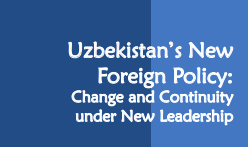
Iran's Azerbaijan Question in Evolution: Identity, Society and Regional Security
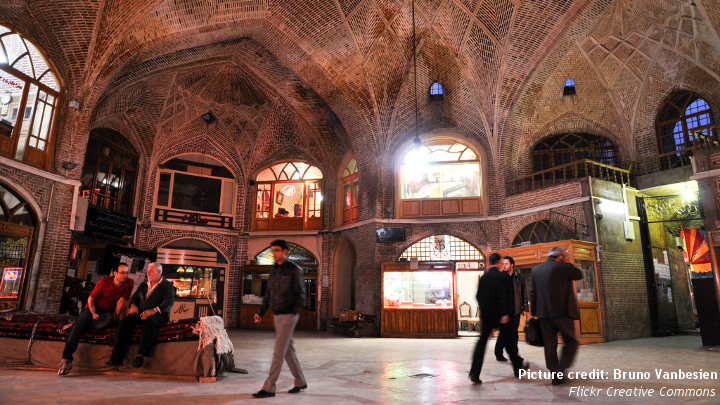
Party Problems and Factionalism in Soviet Uzbekistan: Evidence from the Communist Party Archives
The International Politics of the Armenian-Azerbaijani Conflict
